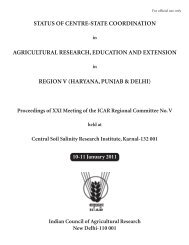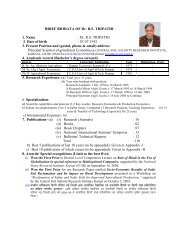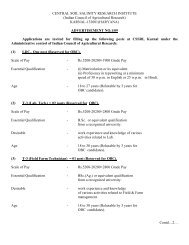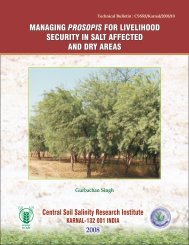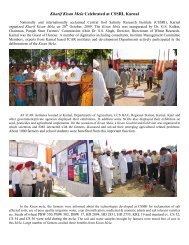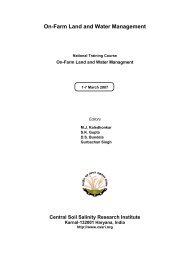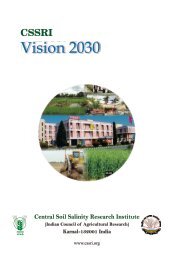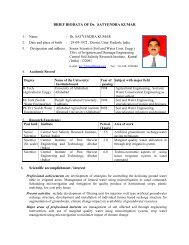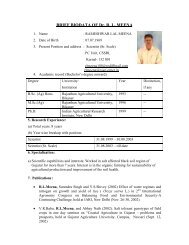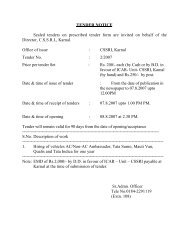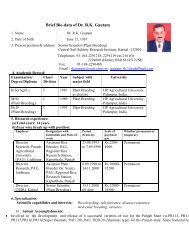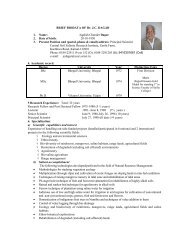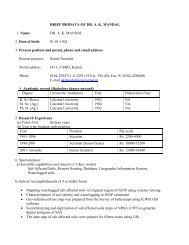BIOSAFOR - BIOSALINE (AGRO) FORESTRY - Central Soil Salinity ...
BIOSAFOR - BIOSALINE (AGRO) FORESTRY - Central Soil Salinity ...
BIOSAFOR - BIOSALINE (AGRO) FORESTRY - Central Soil Salinity ...
Create successful ePaper yourself
Turn your PDF publications into a flip-book with our unique Google optimized e-Paper software.
WORK PACKAGE 1<br />
The objective of WP 1 at CSSRI was to select a number of tree species/ accessions/varieties with good<br />
production characteristics for saline environments and to produce relevant salinity data about these species.<br />
Methods<br />
Nurseries of ten species namely, Prosopis alba (0465), Prosopis alba, Prosopis juliflora, Acacia nilotica, Eucalyptus<br />
tereticornis, Tamarix articulata, Pongamia pinnata, Jatropha curcas, Terminalia arjuna and Cassia siamea were<br />
planted in 20 kg capacity porcelain pots filled with thoroughly washed coarse river sand. Six months old<br />
uniform seedlings were planted. All the pots were supplied with half-strength Hoagland's nutrient solution<br />
(Annexure I) for the first week and subsequently supplemented with mixture of salts as per the composition.<br />
-1<br />
EC level of non-saline control pots was 0.40 dS m . A salt mixture of NaCl, CaCl 2 and MgSO 4 was used to<br />
impose salinities (Annexure I). In most of the pot and solution culture studies reported in literature, single salt<br />
namely NaCl is used to impose salt stress. In natural saline conditions, saline conditions normally occur due<br />
to the presence of mixture of salts namely NaCl, Na2SO 4, CaCl 2, CaSO 4, MgSO 4 etc. with predominance of<br />
NaCl. More over, single salts are normally more toxic in nature having more detrimental effects on plants.<br />
Therefore, we used salt mixture to impose salinity treatments to simulate natural conditions so that more<br />
realistic results are obtained. Therefore, the four levels of salinity treatments were created by using salts<br />
mixture and by increasing salt concentration in step-wise increments. Four salinity levels of 7.5, 12.0, 15.5 and<br />
-1<br />
19.0 dS m were achieved in two, three, four and five increments, respectively in the subsequent three weeks.<br />
This approach using slow and step-wise increments of salinity helps the plants to adjust and avoid shocks due<br />
to sudden imposition of salinity.<br />
-1<br />
For the second year, the salinity levels were further stepped up with the maximum level up to 42 dS m .<br />
Mixture of NaCl and CaCl 2 salts was used to create salinities during the second year as per the decision taken<br />
in the Technical Review Meeting of the project held in ICBA, Dubai during July 2008 (Fig. 2). Eight<br />
replications per treatment were maintained out of which four replicates per treatment were harvested,<br />
washed and sampled after fourteen months of salinity treatment and the remaining after two years of<br />
salinization and separated in to roots, stem and leaves and processed for chemical analysis. Data on shoot<br />
biomass (stem, branches and leaves) and total plant biomass (all plant parts i.e. roots, stem, branches and<br />
leaves) were used to generate salinity response curves for these tree species.<br />
Fig. 2 : Participants of the Technical Review Meeting of Biosafor project from July 20 to 22, 2008<br />
at International Center for Biosaline Agriculture (ICBA), Dubai, UAE<br />
for discussions on methodologies and programmes.<br />
5



